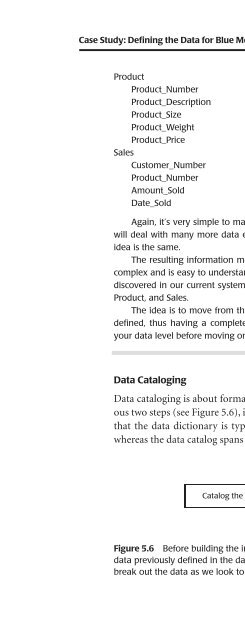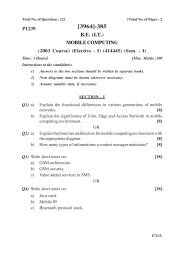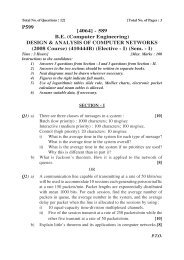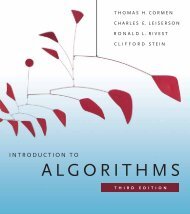- Page 2:
Praise for Cloud Computing and SOA
- Page 6:
Cloud Computing and SOA Convergence
- Page 10:
Cloud Computing and SOA Convergence
- Page 14:
In memory of Spanky, the world’s
- Page 18:
Contents Preface xv Acknowledgments
- Page 22:
Contents xi Selecting a Problem Dom
- Page 26:
Contents xiii Analyze and Test Cand
- Page 30:
Preface The movement to cloud compu
- Page 34:
Preface xvii According to Evans Dat
- Page 38:
Preface xix This book is written fo
- Page 42:
Acknowledgments There are a bunch o
- Page 46:
About the Author David S. Linthicum
- Page 50:
CHAPTER 1 Where We Are, How We Got
- Page 54:
How Things Got Off Track 3 magazine
- Page 58:
What the Heck Is SOA, and Why Shoul
- Page 62:
SOA Meets Cloud Computing 7 service
- Page 66:
Defining Cloud Computing 9 Defining
- Page 70:
The Components of Cloud Computing 1
- Page 74:
The Components of Cloud Computing 1
- Page 78:
What SOA Can Learn from Cloud Compu
- Page 82:
Making the Leap 17 Driving from the
- Page 86:
Being Positively Disruptive 19 must
- Page 90:
CHAPTER 2 Reaching for the Clouds C
- Page 94:
Diving Deeper into Cloud Computing
- Page 98:
What’s New in the Clouds 25 ticul
- Page 102:
What’s New in the Clouds 27 accep
- Page 106:
Cloud Computing Benefits and Drawba
- Page 110:
Cloud Computing Benefits and Drawba
- Page 114:
When the Cloud Fits 33 Service-leve
- Page 118:
Doing Something Different 35 When t
- Page 122:
CHAPTER 3 Defining the Clouds for t
- Page 126:
Storage-as-a-Service 39 move throug
- Page 130:
Database-as-a-Service 41 instance,
- Page 134:
Information-as-a-Service 43 the rig
- Page 138:
Information-as-a-Service 45 estimat
- Page 142:
Information-as-a-Service 47 For ins
- Page 146:
Process-as-a-Service 49 SOAP/ HTTP
- Page 150:
Application-as-a-Service 51 Applica
- Page 154:
Platform-as-a-Service 53 Finally, i
- Page 158:
Integration-as-a-Service 55 The adv
- Page 162:
Testing-as-a-Service 57 Management/
- Page 166:
Next Steps 59 portant is that you r
- Page 170:
CHAPTER 4 Making the Business Case
- Page 174:
Defining the Holistic Value 63 On-P
- Page 178:
Defining the Holistic Value 65 It a
- Page 182:
Defining the Holistic Value 67 Make
- Page 186:
Defining the Holistic Value 69 Down
- Page 190:
Defining the Holistic Value 71 When
- Page 194:
Defining the Holistic Value 73 the
- Page 198: Defining the Holistic Value 75 The
- Page 202: Defining the Holistic Value 77 Step
- Page 206: It’s All about the Business 79 4.
- Page 210: CHAPTER 5 Working from Your Data to
- Page 214: Old or New 83 The advantage of crea
- Page 218: Data First 85 The reason we recomme
- Page 222: Defining the Information Model 87 m
- Page 226: Defining the Information Model 89 U
- Page 230: Defining the Information Model 91 o
- Page 234: Defining the Information Model 93 U
- Page 238: Defining the Information Model 95 U
- Page 242: Case Study: Defining the Data for B
- Page 246: Case Study: Defining the Data for B
- Page 252: 102 Chapter 5 Working from Your Da
- Page 256: 104 Chapter 5 Working from Your Da
- Page 260: 106 Chapter 5 Working from Your Da
- Page 264: 108 Chapter 6 Working from Your Se
- Page 268: 110 Chapter 6 Working from Your Se
- Page 272: 112 Chapter 6 Working from Your Se
- Page 276: 114 Chapter 6 Working from Your Se
- Page 280: 116 Chapter 6 Working from Your Se
- Page 284: 118 Chapter 6 Working from Your Se
- Page 288: 120 Chapter 6 Working from Your Se
- Page 292: 122 Chapter 6 Working from Your Se
- Page 296: 124 Chapter 6 Working from Your Se
- Page 300:
126 Chapter 6 Working from Your Se
- Page 304:
128 Chapter 7 Working from Your Pr
- Page 308:
130 Chapter 7 Working from Your Pr
- Page 312:
132 Chapter 7 Working from Your Pr
- Page 316:
134 Chapter 7 Working from Your Pr
- Page 320:
136 Chapter 7 Working from Your Pr
- Page 324:
138 Chapter 7 Working from Your Pr
- Page 328:
140 Chapter 7 Working from Your Pr
- Page 332:
142 Chapter 7 Working from Your Pr
- Page 336:
This page intentionally left blank
- Page 340:
146 Chapter 8 Bringing Governance
- Page 344:
148 Chapter 8 Bringing Governance
- Page 348:
150 Chapter 8 Bringing Governance
- Page 352:
152 Chapter 8 Bringing Governance
- Page 356:
154 Chapter 8 Bringing Governance
- Page 360:
156 Chapter 8 Bringing Governance
- Page 364:
158 Chapter 8 Bringing Governance
- Page 368:
160 Chapter 8 Bringing Governance
- Page 372:
This page intentionally left blank
- Page 376:
164 Chapter 9 Testing from SOA to
- Page 380:
166 Chapter 9 Testing from SOA to
- Page 384:
168 Chapter 9 Testing from SOA to
- Page 388:
170 Chapter 9 Testing from SOA to
- Page 392:
172 Chapter 9 Testing from SOA to
- Page 396:
174 Chapter 9 Testing from SOA to
- Page 400:
176 Chapter 9 Testing from SOA to
- Page 404:
This page intentionally left blank
- Page 408:
180 Chapter 10 Defining Candidate
- Page 412:
182 Chapter 10 Defining Candidate
- Page 416:
184 Chapter 10 Defining Candidate
- Page 420:
186 Chapter 10 Defining Candidate
- Page 424:
188 Chapter 10 Defining Candidate
- Page 428:
190 Chapter 10 Defining Candidate
- Page 432:
192 Chapter 10 Defining Candidate
- Page 436:
194 Chapter 10 Defining Candidate
- Page 440:
This page intentionally left blank
- Page 444:
198 Chapter 11 Making the Move to
- Page 448:
200 Chapter 11 Making the Move to
- Page 452:
202 Chapter 11 Making the Move to
- Page 456:
204 Chapter 11 Making the Move to
- Page 460:
206 Chapter 11 Making the Move to
- Page 464:
208 Chapter 11 Making the Move to
- Page 468:
210 Chapter 11 Making the Move to
- Page 472:
212 Chapter 11 Making the Move to
- Page 476:
214 Chapter 11 Making the Move to
- Page 480:
This page intentionally left blank
- Page 484:
218 Chapter 12 Moving Onward Q: In
- Page 488:
220 Chapter 12 Moving Onward using
- Page 492:
222 Chapter 12 Moving Onward code
- Page 496:
224 Chapter 12 Moving Onward The e
- Page 500:
226 Chapter 12 Moving Onward The r
- Page 504:
228 Chapter 12 Moving Onward Q: Wh
- Page 508:
This page intentionally left blank
- Page 512:
232 Index BPM, continued semantics,
- Page 516:
234 Index Data for clouds, continue
- Page 520:
236 Index Integration-as-a-service,
- Page 524:
238 Index Services for clouds, cont
- Page 528:
FREE Online Edition Your purchase o












